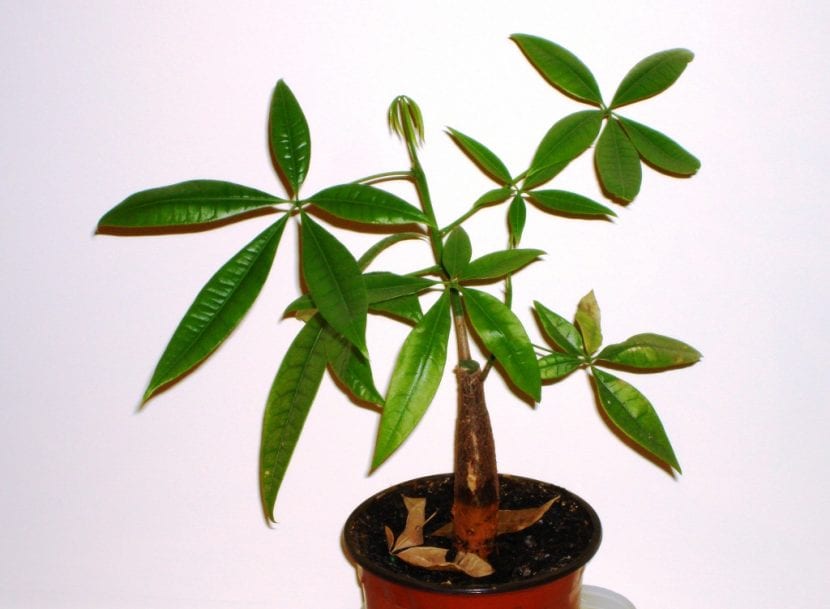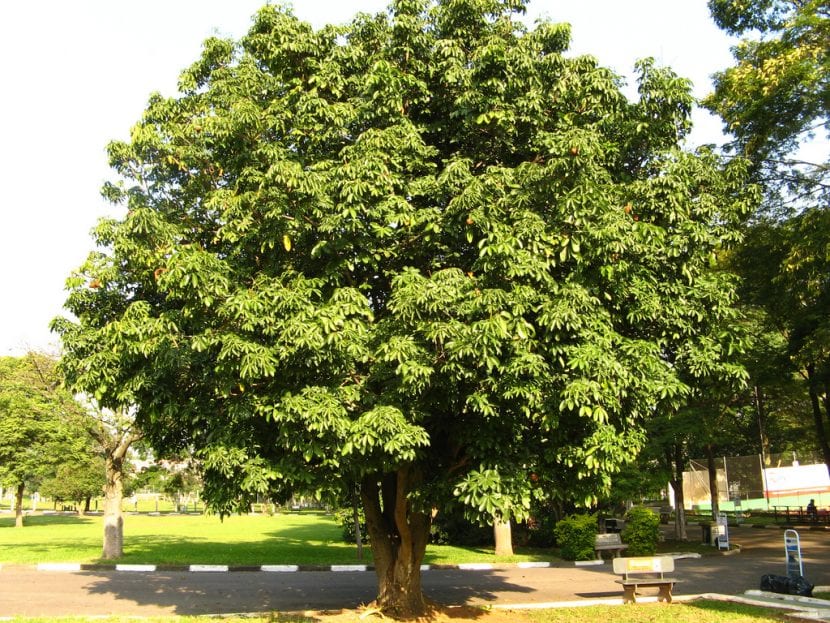
One of the trees most used to decorate interiors is the pachira, a wonderful palm leaf plant that looks great in bright and spacious rooms, as well as patios and tropical gardens.
If you have been given (or have given yourself) one and you would like to know absolutely everything about it, do not hesitate: keep reading to know its characteristics, as well as its care.
Origin and characteristics of the Pachira

Our protagonist is a tree native to the marshy areas of Mexico and northern South America that receives many common names, such as these: water chestnut, Guayana chestnut, water sapote, water zapotón, water ceiba, water ceibo, ceibón of water, apompo, wild cocoa. It reaches a height of between 15 and 20 meters, and has a crown composed of palm leaves between 25 and 35cm, leathery and shiny.
The flowers, which are scented, are grouped in pompom-shaped inflorescences, dark pink in color. The fruit is a woody capsule inside which can be found either many small or few large seeds.
How do you take care of yourself?
If you have a copy, we recommend that you provide the following care:
Climate
It is important to know what climate it supports if we intend to grow it outdoors, as that way we will not get any surprises. In the case of Pachira, we have to know that it is a tropical plant, so You can only have it outside if the temperature never drops below 0 degrees..
Location
- Interior: if the weather is not good in autumn-winter, or if we want to have it indoors, we will have to place it in a room where a lot of natural light enters and is away from drafts (both cold and warm).
- Body exterior:: it has to be in semi-shade (where it receives more light than shade).
Earth
- Flower pot: I advise to use universal growing medium mixed with 30% perlite or river sand.
- Garden: must have good drainage and be rich in organic matter.
Irrigation
The watering of this tree has to be frequent in summer but somewhat more scarce the rest of the year, especially when the weather is not good. Thus, generally, We will water every 2-3 days in the summer season and every week the rest of the year.
Subscriber

From early spring to late summer / early fall we must pay it with Organic fertilizers liquids, such as guano, following the indications specified on the product packaging.
Planting or transplanting time
The best time to spend it in the garden will be in spring. In the case of having it in a pot, we will transplant it to a larger one every 2 years.
Multiplication
In spring, either by seeds or by cuttings. Let's see how to proceed in each case:
Seeds
To multiply it by seeds you have to do the following:
- First we fill a seedbed (seedling tray, flowerpot, milk container or whatever we have on hand) with universal culture substrate mixed with 30% perlite. It is important that said seedbed has at least one hole for water drainage.
- Afterwards, we put a maximum of three seeds in each one, putting them a little apart from each other.
- Then we sprinkle copper or sulfur to prevent fungus.
- Finally, we cover them with substrate and water.
If all goes well, the first seedlings will germinate in 15-30 days.
Cuttings
To multiply by cuttings you have to do the following:
- First, a branch of about 40 centimeters is taken.
- The base is then impregnated with powdered rooting hormones or with homemade rooting agents.
- Afterwards, it is planted in a pot with vermiculite.
- Finally, it is watered and placed outside, in semi-shade.
Thus, we will obtain a new Pachira after about 30 days.
Pruning
If it grows in excess, branches can be trimmed in late winter. Likewise, dry, diseased or weak branches must be removed.
Rusticity
It is very sensitive to cold and frost.
What is Pachira for?

Ornamental
The most widespread use of this magnificent tree is for ornamental purposes. Looks great in spacious gardens, either as an isolated specimen or in groups, where it gives a pleasant shade. In addition, in a pot it decorates any corner from an early age, so it is always a luxury to have it.
Food
The seeds are collected and roasted in their places of origin, where they say they have a flavor similar to that of walnut. So if you are lucky enough to live in an area with a tropical climate, you already know that with Pachira you will have a very, very practical tree, since the new leaves and flowers are also edible.
Wood
The wood that is extracted from its trunk used to make small objectssuch as wooden spoons and forks, picture frames, etc.

The Pachira is a plant that, seeing it in a nursery, gives us the feeling that it has to be small. Although that is not true, it does have a very high ornamental value that, with a minimum of care, we can enjoy.
Where can I buy this pachira plant, I wish you would give me an answer, thank you
Hello Maria Cristina.
Where are you from? These plants are sold in nurseries, both online and physical. Sometimes also in large shopping centers. On Amazon you have it too.
Regards!
I live in Angola and I planted a pachila I do not want to know how to make a pachira nao cresça muito
Hello
To limit the growth of pachira, or that it can be feito é:
-no pay
-water as soon as necessary
-e prune seus galhos um little every year
Greetings.
Hello, it is the fourth pachira that I have, and almost always it has been peeled, I have a very good light at home, the watering because perhaps I have passed, now I keep it quite well, the leaves fall off, although it is reproducing with ease. Thanks for such good information. I hope to save this one that I have.
Hello Lola.
Yes, the pachira problem is almost always a bad watering.
It is best to plant it in a pot with holes, and put a plate under it so as not to stain the ground. But after each watering it must be drained so that the roots do not rot.
In case you have doubts, write to us 🙂
Greetings.